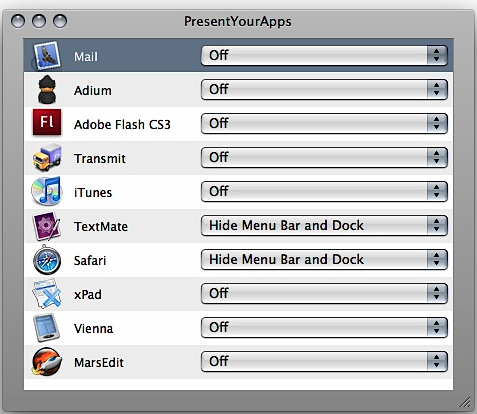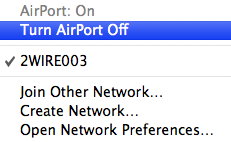Archive
How To Play Software Instruments In Garageband

Here’s a quick how-to for those beginning to use Garageband. Garageband has a nice library of software instruments available, allowing you to make your own tunes as opposed to solely using loops. Here’s how you do it.
When you create a new Garageband project, you will start with the piano software instrument (unless you initially selected to start with another instrument). If you want to play the piano, simply go Window > Musical typing or press Apple-K. Now a virtual keyboard will appear.

One the top left corner of the window, click the button with the A. Now sounds will play according to each key you hit. To select different software instruments, click the I logo on the bottom right of Garageband. If you want multiple software instruments, select the + icon on the bottom left of Garageband and select software instrument.
– Alexander Garovi
Tip 17: Changing The Dock Theme
LeopardDocks is simple application that changes the Dock Theme. Its straightforward UI makes it very easy to modify your Dock and undo changes. I highly recommend LeopardDocks to anyone who wants to give their dock a little personality.

Dock Themes
On the LeopardDocks website, there is a collection of various Dock themes that can be downloaded.
To Change The Theme
1. Download and Launch LeopardDocks. Download a theme from leoparddocks.com
2. In LeopardDocks, browse for the downloaded theme

3. Select the theme, click “Change My Dock” and confirm the changes with your password.
The Dock theme will now change
– Alexander Garovi
Tip 14: More Frequent Auto Saves In Microsoft Word
 Here’s another Microsoft Word Tip. Saving your work is always important, in order to prevent frustrating data loss. Luckily, if you sometimes forget to save, Word auto saves your progress at a default setting of every 10 minutes. You can even shorten this amount of time and make auto saves more frequent. Here’s how you do it:
Here’s another Microsoft Word Tip. Saving your work is always important, in order to prevent frustrating data loss. Luckily, if you sometimes forget to save, Word auto saves your progress at a default setting of every 10 minutes. You can even shorten this amount of time and make auto saves more frequent. Here’s how you do it:
1. Open Microsoft Word
2. With a document open, go File > System Preferences (Command-,)
3. In the Output and Sharing section, select Save
4. You will see a checkbox next to “Save AutoRecover info every (set amount of time) minutes”
![]()
5. Enter the amount of time between auto saves
Note: I believe you have to save one time manually, before the auto save function works.
This tip concludes today’s Microsoft Word tips.
– Alexander Garovi
Tip 13: Changing The Default Font In Microsoft Word
 If you want to give your docs a new look, changing the default font is very easy to do. Here’s how you do it:
If you want to give your docs a new look, changing the default font is very easy to do. Here’s how you do it:
1. Open Microsoft Word
2. Open a document, or create a New Blank Document
3. Go Format > Font (Command-D)
4. Select the font, size, font styles etc.
5. On the bottom-left hand corner of the window, click Default
6. A box asking if you want to change the default font will appear. Click Yes

Your default font will now be the selected one. More quick Microsoft Word tips are on the way.
– Alexander Garovi
Tip 12: Renaming Bootcamp Partitions
Tired of seeing the name, “untitled” under your Bootcamp partition? With a few easy steps, you can change it to something more interesting. Before changing the partition’s name, you must reboot into Windows. Unable to take screenshots in Windows, I was forced to use my camera :-/. Here’s how you do it:
1. Reboot into Windows
2. Go Start > My Computer
3. You will see the C: named “UNTITLED”.

4. Highlight the HD’s name, enter a new name and press Enter

5. Reboot in OS X and you should see your partition with its new name. The only issue with this tweak is that the new name will be in caps.
Before:

After:

I personally don’t use a name at all – At startup in OS X, highlight the partition’s name and press Spacebar and Enter. This must be done in OS X, because Windows doesn’t permit empty Disk names. At the computer’s next startup, the name will be changed back to “Untitled”.

– Alexander Garovi
6 Ways To Stay Focused On Your Work
Sometimes, when there’s an important paper or project that needs to be finished, your Mac can be the biggest thing in your your way from working productively. Accessing the consuming websites and apps we all use can be very distracting. Here are some apps and tips to help you stay focused on your work.

1. Think allows you to limit your attention to any one application and easily change focus if necessary. Think uses an Illumination Panel, allowing you to choose an application on which to focus. The Think Backdrop shields you from outside distractions, as the Desktop and other applications are hidden behind it to keep you focused on your work. Think is a free app and can be downloaded here.

2. Concentrate helps you work more productively by getting rid of distractions. Concentrate allows you to create activities and select actions that correspond to each activity. With Concentrate, you can quit any distracting apps, block distracting websites, add sound alerts, make sound messages to keep you on task, run scripts to remove any unique distractions and more. Concentrate’s 60 hour free trial is available for download here.

3. WriteRoom is a distraction free writing program that emulates the simplicity of the typewriter. WriteRoom offers different colors, fonts, page layouts, an optional scroll-bar and optional spell-checking. With WriteRoom, its just you and the text without any distractions. WriteRoom’s free trail can be downloaded here.

4. PresentYourApps is an application that allows you hide the Dock and menu bar. PresentYourApps opens up a lot of extra screen space that allows you to work better. PresentYourApps is free and can be downloaded here.

5. Spaces is a great component of OS X Leopard that allows you to assign applications to individual desktop Spaces. It is a great way to keep your desktop organized and keep you focused on the apps you’re using. For example, I assigned a space to my productivity applications such as Word, Excel etc. and a separate one to my internet browsers to keep me focused on my work. Spaces can be set up in System Preferences in the Exposé and Spaces section.

6. Turn off your Airport – If you’re like me, you repeatedly switch off between accessing the internet and working. If you have to force yourself to work, I’d suggest turning off your Airport completely.
This concludes today’s tips on staying focused in OS X.
– Alexander Garovi
Control Multiple Cameras With Cameras
 Cameras by Flexibits is a System Preferences application that lets you manage your cameras when you connect your camera, iPhone, digital media reader or any other photo device to your computer. In addition, you can select which applications will open when a camera is connected and set your images to download automatically. If you have multiple cameras, Cameras is the right tool to use. This app is very easy to use and is free to download.
Cameras by Flexibits is a System Preferences application that lets you manage your cameras when you connect your camera, iPhone, digital media reader or any other photo device to your computer. In addition, you can select which applications will open when a camera is connected and set your images to download automatically. If you have multiple cameras, Cameras is the right tool to use. This app is very easy to use and is free to download.

– Alexander Garovi
How To Create An iMix In iTunes
Here’s another iTunes how-to – making iMixes. iMixes are playlists that are published in the iTunes store and can be purchased. Making one is fast and easy. Here’s how you do it:
1. Open iTunes and create a playlist of selected songs
2. After creating the playlist, on the menu bar click Store > Create an iMix
3. Name and give a description of the playlist

You will be notified when when your iMix is published.
– Alexander Garovi
How To Have Multiple iTunes Libraries
Most iTunes users use its well known playlist feature, allowing you to make playlists of selected songs. Not only can you customize your iTunes with playlists, but you can even have multiple libraries. Some reasons for having multiple libraries would be to separate music based on genre, or occasion. Different libraries can also be used to separate lossless from lossy files. Here’s how you can set up multiple iTunes libraries:
1. Before opening iTunes, hold down Alt.
2. A popup will come up, giving the option to select or create a library

Note:
iTunes will open the library that was last opened. In order to select another library, repeat the steps above.
– Alexander Garovi
3 Useful Websites for Photoshop Work
Photoshop offers plenty of fonts and brushes that you can use to fully personalize your masterpieces. However, sometimes you need that special brush, font or render to add to your work. Here are some useful websites that can help you with your Photoshop work.

1. PlanetRenders.net is a render sharing website where users post their self-made renders. This website is extremely useful if you need renders for your signatures or other pictures. The website is free to register and has a great selection of renders for pretty much anything.

2. DaFont.com is a free font website with a huge selection of fonts that can be used in Photoshop. Da Font selection ranges from all sorts of font styles. To install a font:
a. Download the font
b. Unzip the zip font file
c. Open the unzipped .ttf file
d. Click Install Font


3. Brusheezy is a free website, where artists download and vote for custom Photoshop brushes. New creative brushes are added daily and range from a variety of designs. To install brushes:
a. Download a brush

b. Unzip the zip brush file
c. Open Photoshop
d. Select the brush icon on the panel
e. Select the brush option icon on the upper-left panel (Arrow 1)
f. Click the right arrow button on the window and select Load Brushes (Arrow 2)
e. Load the brush

These websites are very helpful for Photoshop design. I especially use these sites for my Photoshop signature work and highly recommend them for yours.
– Alexander Garovi
